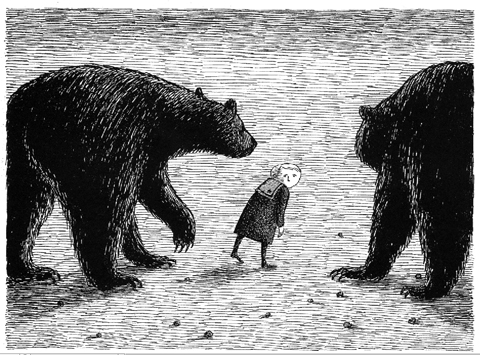
'B IS FOR BASIL' First published in The Gashlycrumb Tinies, 1963; pen and ink by Edward Gorey. |
Events in the art business have been evoking the past for me these days, a function, I suppose, of accumulating high mileage. Two very different occasions have me glancing into the rearview mirror. One is the acquisition by gift of a good-sized Tony Caro steel sculpture by the Portland Museum of Art. Caro was one of the reasons I started working the way I worked, about which more later.
The other event needs a brief anecdote. In my aimless youthful days circa 1964 I met a young woman with a curious turn of mind. She wore sandals and loose dresses, and was given to impulsive laughter and unplanned trips to places like Provincetown. She had TheRealist magazines, painted pictures, and once showed me a little illustrated story book I've never forgotten. It was Edward Gorey's The Curious Sofa: A Pornographic Work by Ogdred Weary.
It wasn't really pornographic unless you read things into its suggestions, and it was funny and truly enigmatic — you had to make up what happened at the end when Sir Egbert pulled the lever and started the sofa's machinery. It was my first conscious encounter with powerful uncertainty as an artistic trope, and I was hooked.
The Portland Public Library has mounted an excellent show of a large number of Gorey's work, including original pen-and-ink drawings from his many illustrations and books, ephemera, studies, and letters. For those new to his immense, peculiar, and quite wonderful body of work, this show is a fantastic introduction.
Of course these days that can't be too many people, unless they're pretty young. For years Gorey's work reached a mostly cult audience, printed by obscure publishers. By the time I first saw his work he'd been creating these books with his characteristic Victorian or Edwardian characters doing odd and sometimes creepy things for a dozen years or more. Since then there were award-winning sets and costumes for the Broadway show Dracula, the titles and credits for the PBS series Mystery!, and many collections of his stories and drawings published by major houses.
Edward Gorey (1925-2000) defies artistic classification. He was usually considered an illustrator — his drawings have adorned editions of T.S. Eliot, H.G. Wells, Bram Stoker, and many children's books. He was also called a surrealist artist, but that doesn't quite fit, either. His works seem to occupy several worlds at once, the mundane, the well-mannered, the comedy universe, and the dream world. How can that family at dinner maintain its decorous manners while the giant crow-like figure in "The Doubtful Guest," seated at the table, evinces an appetite for crockery?
He produced over 100 books, some with text and some not. He lived quietly for much of his life in Yarmouth Port, on Cape Cod, where he would sometimes put on entertainments with his own hand puppets, an ensemble he called Le Theatricule Stoique.
Which is a clever characterization of his work. They are funny, sometimes wistful, always clever and engaging, but always tinged with implicit discomfort or unhappiness. Even in the world that we can imagine, or that Gorey could imagine for us, things usually don't go the way we might wish but we nonetheless soldier on. This show at the Portland Library gives us a close look at his work and his world, where things are never certain, even for children. In one of his alphabet rhymes "A is for Amy who falls down the stairs" while "B is for Basil assaulted by bears."
Gorey's world is an unsettling place, where danger and disorder lurk just behind the veneer of culture and expectations, where the unknown is likely to bring quiet laughter and disaster, wrapped in pen and ink surprises.